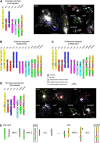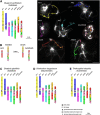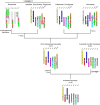Chromosomal phylogeny and karyotype evolution in x=7 crucifer species (Brassicaceae)
- PMID: 18836039
- PMCID: PMC2590746
- DOI: 10.1105/tpc.108.062166
Chromosomal phylogeny and karyotype evolution in x=7 crucifer species (Brassicaceae)
Abstract
Karyotype evolution in species with identical chromosome number but belonging to distinct phylogenetic clades is a long-standing question of plant biology, intractable by conventional cytogenetic techniques. Here, we apply comparative chromosome painting (CCP) to reconstruct karyotype evolution in eight species with x=7 (2n=14, 28) chromosomes from six Brassicaceae tribes. CCP data allowed us to reconstruct an ancestral Proto-Calepineae Karyotype (PCK; n=7) shared by all x=7 species analyzed. The PCK has been preserved in the tribes Calepineae, Conringieae, and Noccaeeae, whereas karyotypes of Eutremeae, Isatideae, and Sisymbrieae are characterized by an additional translocation. The inferred chromosomal phylogeny provided compelling evidence for a monophyletic origin of the x=7 tribes. Moreover, chromosomal data along with previously published gene phylogenies strongly suggest the PCK to represent an ancestral karyotype of the tribe Brassiceae prior to its tribe-specific whole-genome triplication. As the PCK shares five chromosomes and conserved associations of genomic blocks with the putative Ancestral Crucifer Karyotype (n=8) of crucifer Lineage I, we propose that both karyotypes descended from a common ancestor. A tentative origin of the PCK via chromosome number reduction from n=8 to n=7 is outlined. Comparative chromosome maps of two important model species, Noccaea caerulescens and Thellungiella halophila, and complete karyotypes of two purported autotetraploid Calepineae species (2n=4x=28) were reconstructed by CCP.
Figures




Similar articles
-
Ancestral chromosomal blocks are triplicated in Brassiceae species with varying chromosome number and genome size.Plant Physiol. 2007 Oct;145(2):402-10. doi: 10.1104/pp.107.104380. Epub 2007 Aug 24. Plant Physiol. 2007. PMID: 17720758 Free PMC article.
-
Karyotype evolution in apomictic Boechera and the origin of the aberrant chromosomes.Plant J. 2015 Jun;82(5):785-93. doi: 10.1111/tpj.12849. Plant J. 2015. PMID: 25864414
-
Reciprocal and multi-species chromosome BAC painting in crucifers (Brassicaceae).Cytogenet Genome Res. 2010 Jul;129(1-3):184-9. doi: 10.1159/000312951. Epub 2010 May 26. Cytogenet Genome Res. 2010. PMID: 20501976
-
Chromosome evolution in Perissodactyla.Cytogenet Genome Res. 2012;137(2-4):208-17. doi: 10.1159/000339900. Epub 2012 Jul 18. Cytogenet Genome Res. 2012. PMID: 22813844 Review.
-
Karyotype evolution in the Pinaceae: implication with molecular phylogeny.Genome. 2012 Nov;55(11):735-53. doi: 10.1139/g2012-061. Epub 2012 Oct 25. Genome. 2012. PMID: 23199570 Review.
Cited by
-
Synteny Identifies Reliable Orthologs for Phylogenomics and Comparative Genomics of the Brassicaceae.Genome Biol Evol. 2023 Mar 3;15(3):evad034. doi: 10.1093/gbe/evad034. Genome Biol Evol. 2023. PMID: 36848527 Free PMC article.
-
Chromosome Evolution in the Family Solanaceae.Front Plant Sci. 2022 Jan 28;12:787590. doi: 10.3389/fpls.2021.787590. eCollection 2021. Front Plant Sci. 2022. PMID: 35154179 Free PMC article. Review.
-
Genome Evolution in Arabideae Was Marked by Frequent Centromere Repositioning.Plant Cell. 2020 Mar;32(3):650-665. doi: 10.1105/tpc.19.00557. Epub 2020 Jan 9. Plant Cell. 2020. PMID: 31919297 Free PMC article.
-
Comprehensive Genomic Survey, Characterization and Expression Analysis of the HECT Gene Family in Brassica rapa L. and Brassica oleracea L.Genes (Basel). 2019 May 27;10(5):400. doi: 10.3390/genes10050400. Genes (Basel). 2019. PMID: 31137879 Free PMC article.
-
A chromosome-scale genome assembly of Isatis indigotica, an important medicinal plant used in traditional Chinese medicine: An Isatis genome.Hortic Res. 2020 Feb 1;7:18. doi: 10.1038/s41438-020-0240-5. eCollection 2020. Hortic Res. 2020. PMID: 32025321 Free PMC article.
References
-
- Ali, H.B.M., Lysak, M.A., and Schubert, I. (2005). Chromosomal localization of rDNA in the Brassicaceae. Genome 48 341–346. - PubMed
-
- Al-Shehbaz, I.A., Beilstein, M.A., and Kellogg, E.A. (2006). Systematics and phylogeny of the Brassicaceae (Cruciferae): An overview. Plant Syst. Evol. 259 89–120.
-
- Bailey, C.D., Koch, M.A., Mayer, M., Mummenhoff, K., O'Kane, S.L., Jr., Warwick, S.I., Windham, M.D., and Al-Shehbaz, I.A. (2006). Toward a global phylogeny of the Brassicaceae. Mol. Biol. Evol. 23 2142–2160. - PubMed
-
- Beilstein, M.A., Al-Shehbaz, I.A., and Kellogg, E.A. (2006). Brassicaceae phylogeny and trichome evolution. Am. J. Bot. 93 607–619. - PubMed
-
- Berr, A., Pecinka, A., Meister, A., Kreth, G., Fuchs, J., Blattner, F.R., Lysak, M.A., and Schubert, I. (2006). Chromosome arrangement and nuclear architecture but not centromeric sequences are conserved between Arabidopsis thaliana and Arabidopsis lyrata. Plant J. 48 771–783. - PubMed
Publication types
MeSH terms
Substances
LinkOut - more resources
Full Text Sources
Research Materials

